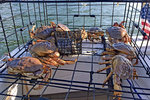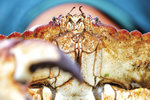

A Key Peninsula tradition — rowing to a favorite spot to set out a crab pot or wading during low tide with a net or a pitchfork to scoop up a meal’s worth of fresh crab — came to a halt in 2018. The near collapse of the Dungeness crab population in South Puget Sound led to prohibition of crabbing in all waters south of the Tacoma Narrows Bridge, designated Marine Area 13 by the Washington State Department of Fish and Wildlife.
Despite the closure there is little sign of improvement, and barring unexpected evidence of recovery, local crabbing will remain on hold for the foreseeable future.
“When we first closed the season in 2018 there was so much public sentiment that all you have to do is close off the fisheries and they will come back,” said Don Velasquez, shellfish manager for the WDFW. “Now we are moving to the problem of if they don’t come back how to deal with people who want to crab.”
The cause of the collapse is probably multifactorial and is still being studied. If overfishing were to blame, populations would have shown signs of recovery by now, Velasquez said.
Recent data from the Pacific Northwest Crab Research Group using light traps showed that the number of larvae in south Puget Sound — the supply side of the equation — is much lower than in the north. Acidification and warming of Puget Sound waters may have an adverse impact on survival in the early stages of development.
Female Dungeness crabs can store sperm after mating for up to two-and-a-half years. Once fertilized eggs are released, the larvae remain suspended in the water for about four months, are carried to their ultimate destination by tides and currents, and then settle to the bottom to mature. It takes about four years for males to reach the legal harvesting size of 6.25 inches. Females cannot be taken.
Although the crab population has declined modestly in the more northern parts of Puget Sound, the devastating loss has been limited to South Puget Sound and the southern end of Hood Canal.
The South Sound has never been open to state commercial crabbing, leaving the harvest to be split between tribal and recreational fishers.
Historically the total catch has been less than 5% of the state total. The Dungeness harvest peaked in Marine Area 13 in 2012 at 285,505 pounds and fell to 9,457 pounds in 2017, a decline of 96.7%. By contrast, the northern fishery harvest peaked at more than 10 million pounds in 2015-16 and was just over 8 million pounds this year.
Washington State has 13 marine areas encompassing the Pacific coast, the Strait of Juan de Fuca and Puget Sound. The Dungeness harvest is recorded each year by marine area, and since 2015 WDFW has evaluated the crab population with preseason test trapping.
Test traps for Marine Area 13 are set in late February. Fifteen traps, with a mesh diameter of 5 inches, are placed in each of eight locations for 24 hours. The number, size and gender of each crab is recorded. In 2015, there were an average of 2.43 crabs per trap. That fell to 0.68 in 2018; there was a modest increase to 1.16 in 2022. Of those, 82% were legal-sized males. Traps in the Whidbey Island region typically have 15 to 20 times the number of crabs and a wider distribution of sizes.
“It is like someone turned off the faucet. The little ones are not coming back into the system,” Velazquez said of Marine Area 13.
There has been pressure on WDFW to allow red rock crab fishing, but a number of factors make that unlikely. Enforcement would be difficult and there would be risk of injury to Dungeness crabs trapped and released.
Velasquez said that some areas may open for red rock crab where it is known Dungeness crabs are rare, and if methods other than traps are used. But there are administrative hurdles. By law all crab harvesting must be shared with the tribes, and at this point there is no process for estimating the red rock population or how many are harvested. These details would all have to be resolved.
In addition, although red rock crabs are faring better than Dungeness, their numbers have also declined. The average total number in each trap peaked in 2016 at 10.3. This year the number fell to 3.6.
UNDERWRITTEN BY THE FUND FOR NONPROFIT NEWS (NEWSMATCH) AT THE MIAMI FOUNDATION, THE ANGEL GUILD, ADVERTISERS, DONORS AND PEOPLE WHO SUPPORT INDEPENDENT, NONPROFIT LOCAL NEWS